Abstract
Expression of the X-linked repeated Stellate (Ste) genes, which code for a protein with 38% similarity to the beta-subunit of casein kinase II, is suppressed by the Su(Ste) locus on the Y chromosome. The structure and evolution of the Y-linked repeats in the region of the Su(Ste) locus were studied. The 2800 bp repeats consist of three main elements: the region of homology to the Ste genes, an adjacent AT-rich, Y-specific segment, and mobile element 1360 inserted in the Ste sequence. Amplification of repeats was followed by point mutations, deletions, and insertions of mobile elements. DNA sequencing shows that these repeats may be considered as Ste pseudogenes or as damaged variants of a putative gene(s) encoding a protein quite different from the Ste protein as a result of an alternative splicing pattern. A comparison of 5 variants of the Y-Su(Ste) repeats shows a number of recombination events between amplified and diverged sequences that could be due to either multiple unequal mitotic sister-chromatid exchanges or to gene conversion. It is a first demonstration on a molecular level of these processes occurring in heterochromatic non-rDNA tandemly organized sequences in an eukaryotic genome.
Full text
PDF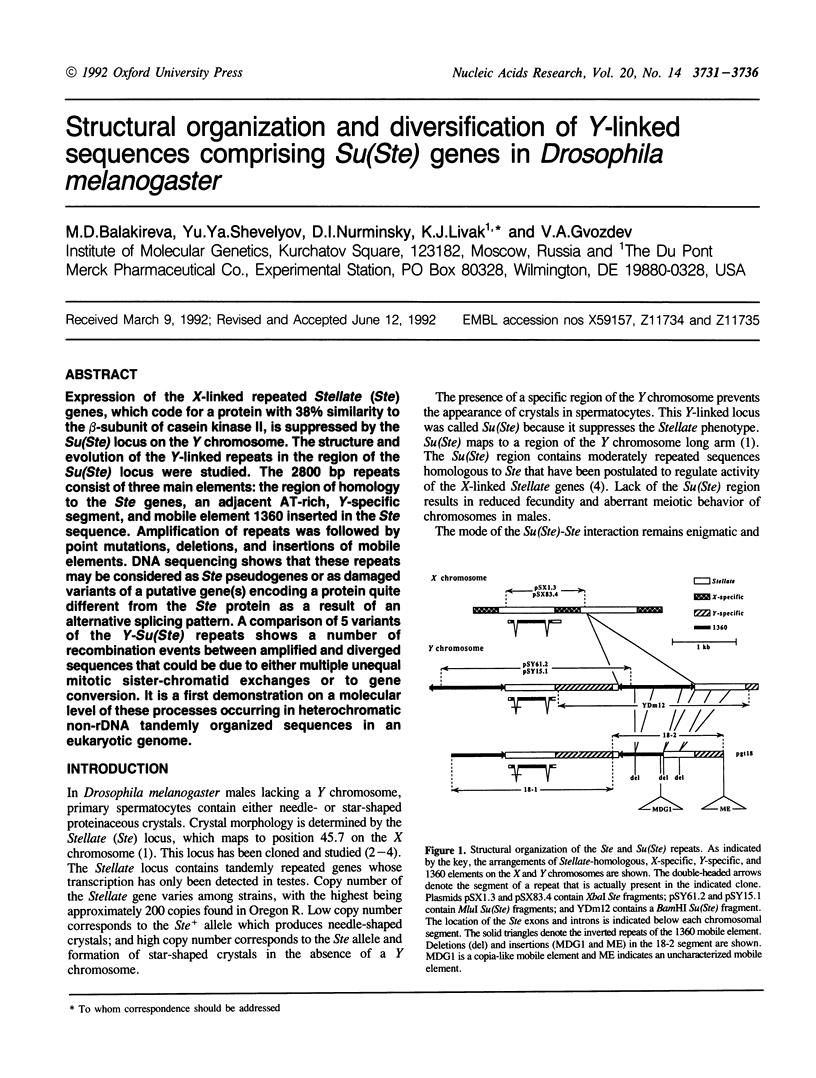
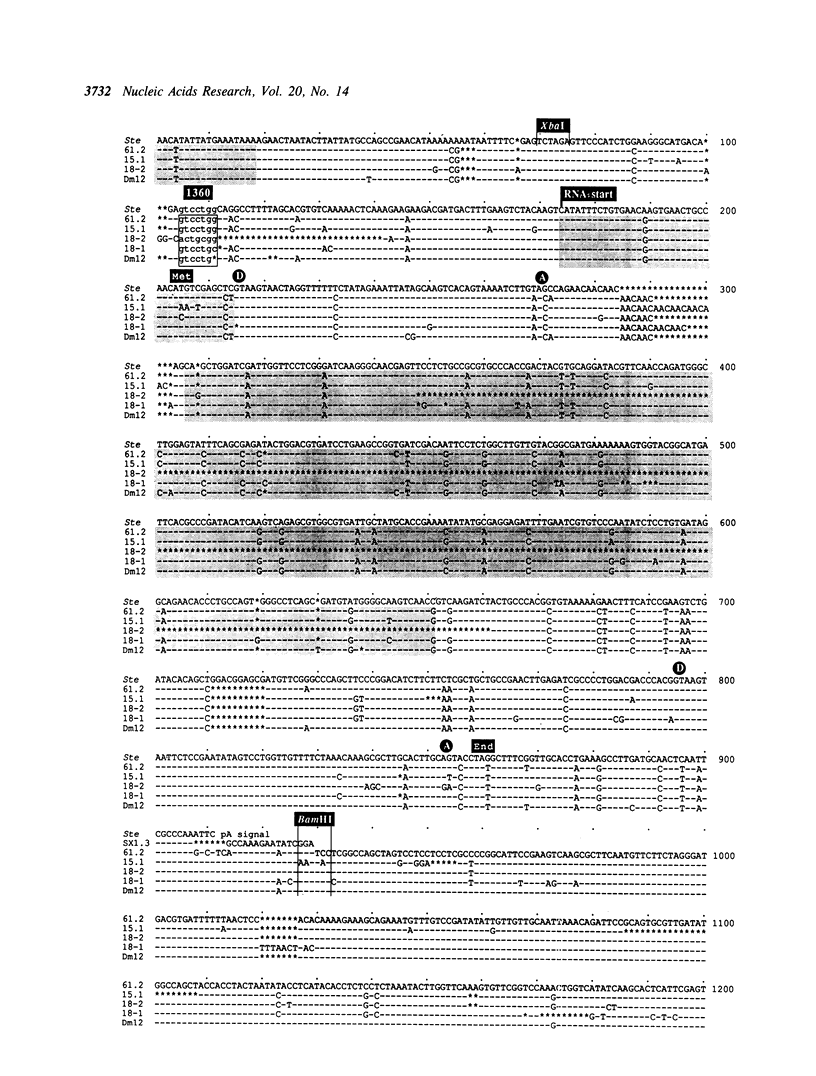
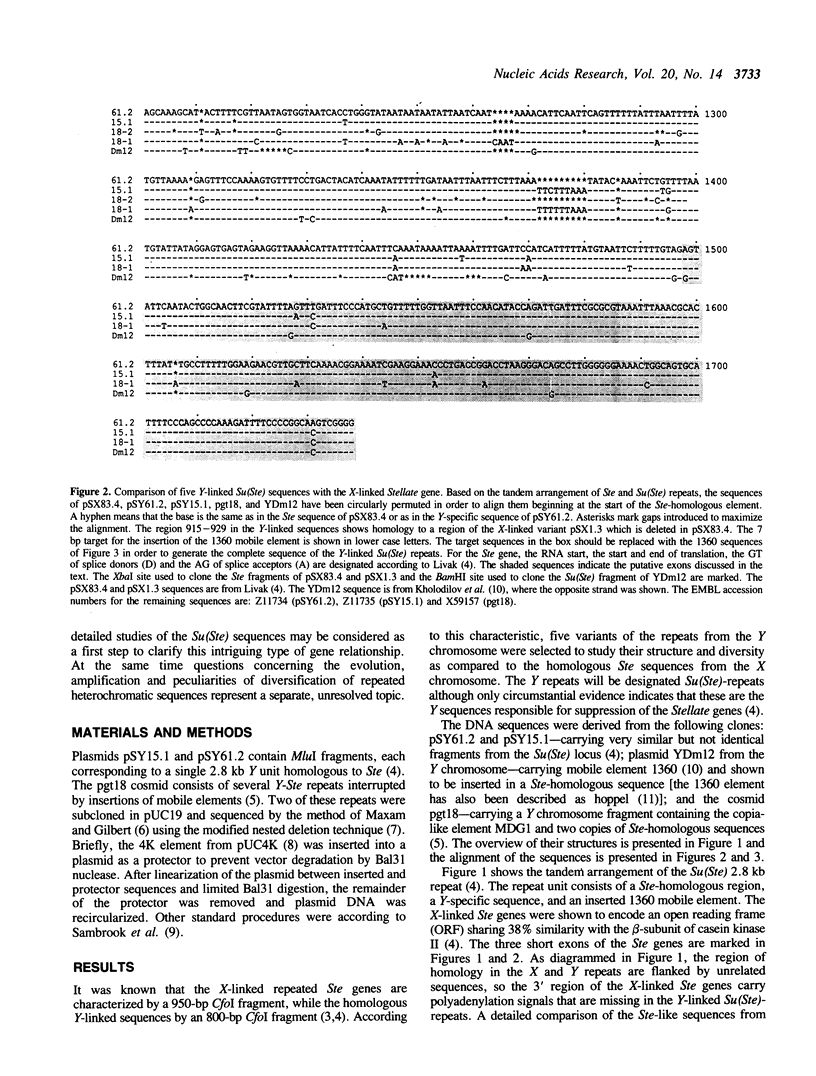
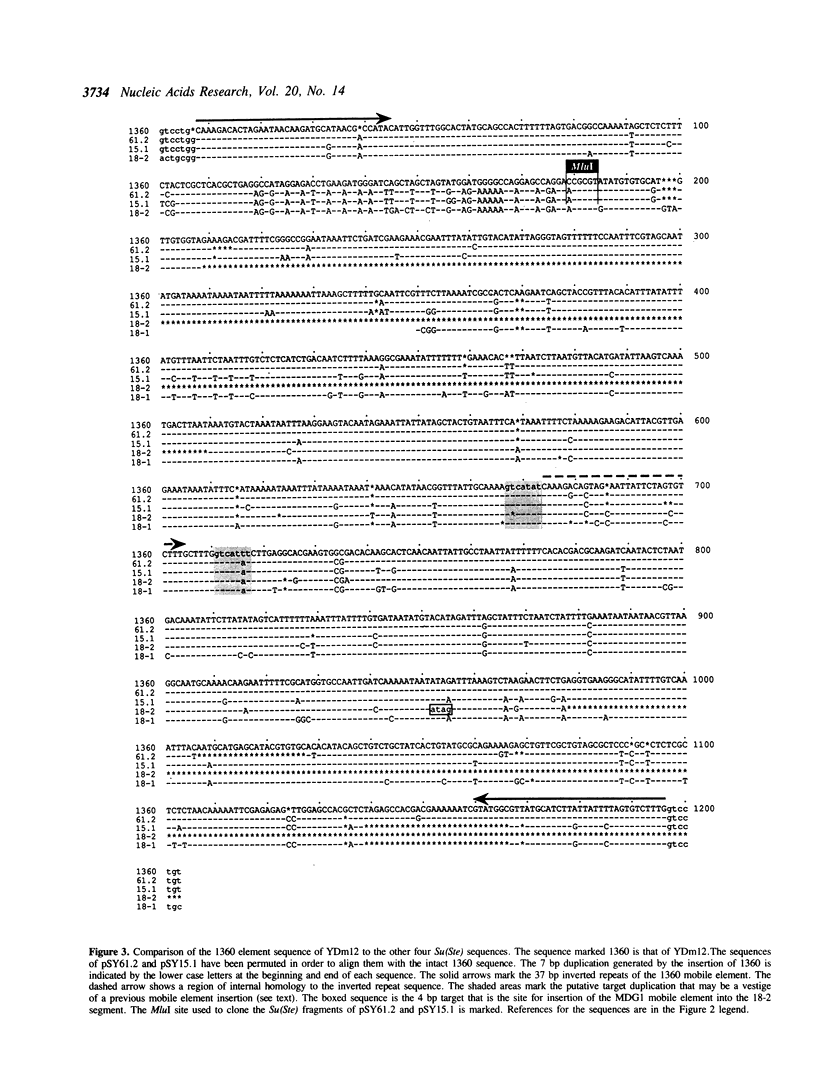
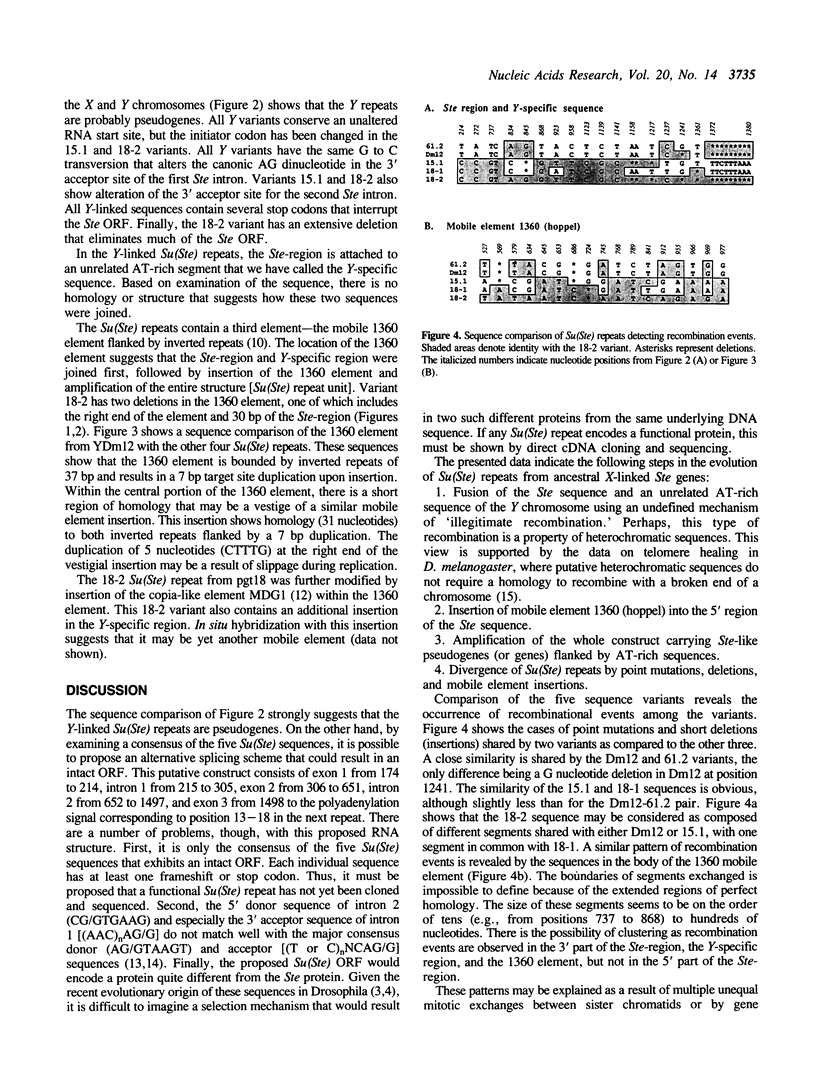
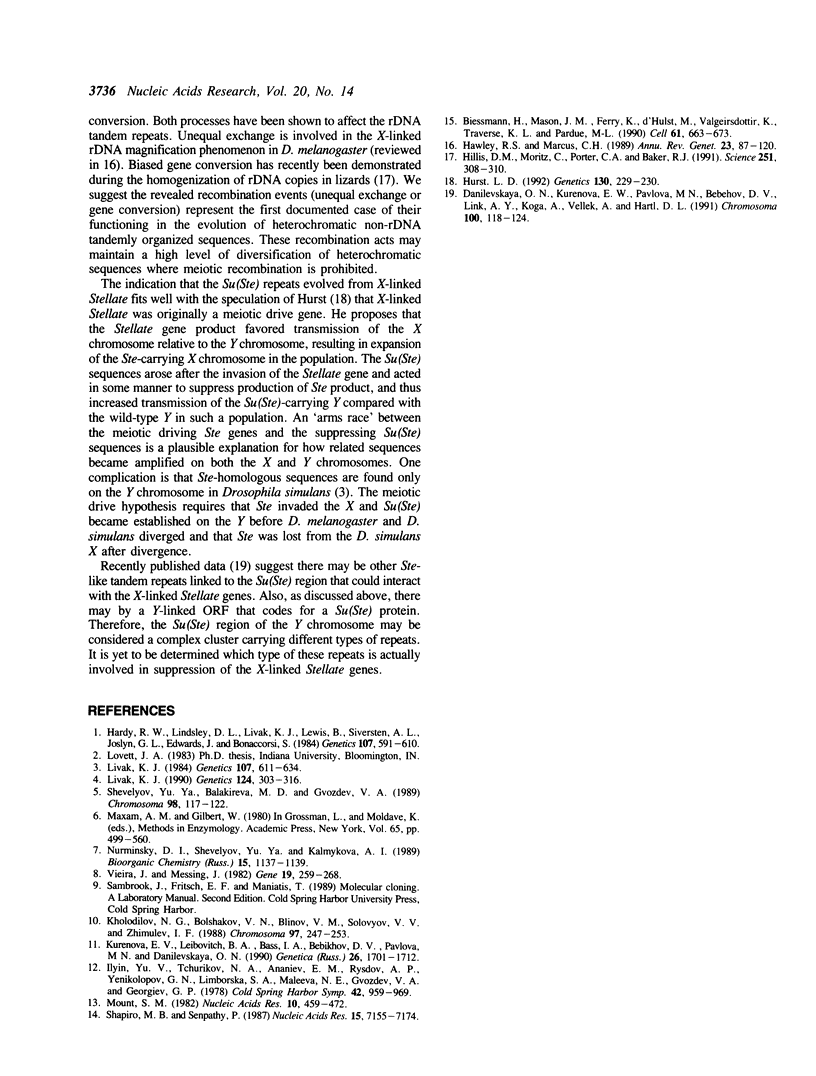
Selected References
These references are in PubMed. This may not be the complete list of references from this article.
- Biessmann H., Mason J. M., Ferry K., d'Hulst M., Valgeirsdottir K., Traverse K. L., Pardue M. L. Addition of telomere-associated HeT DNA sequences "heals" broken chromosome ends in Drosophila. Cell. 1990 May 18;61(4):663–673. doi: 10.1016/0092-8674(90)90478-w. [DOI] [PubMed] [Google Scholar]
- Danilevskaya O. N., Kurenova E. V., Pavlova M. N., Bebehov D. V., Link A. J., Koga A., Vellek A., Hartl D. L. He-T family DNA sequences in the Y chromosome of Drosophila melanogaster share homology with the X-linked stellate genes. Chromosoma. 1991 Feb;100(2):118–124. doi: 10.1007/BF00418245. [DOI] [PubMed] [Google Scholar]
- Hardy R. W., Lindsley D. L., Livak K. J., Lewis B., Siversten A. L., Joslyn G. L., Edwards J., Bonaccorsi S. Cytogenetic analysis of a segment of the Y chromosome of Drosophila melanogaster. Genetics. 1984 Aug;107(4):591–610. doi: 10.1093/genetics/107.4.591. [DOI] [PMC free article] [PubMed] [Google Scholar]
- Hawley R. S., Marcus C. H. Recombinational controls of rDNA redundancy in Drosophila. Annu Rev Genet. 1989;23:87–120. doi: 10.1146/annurev.ge.23.120189.000511. [DOI] [PubMed] [Google Scholar]
- Hillis D. M., Moritz C., Porter C. A., Baker R. J. Evidence for biased gene conversion in concerted evolution of ribosomal DNA. Science. 1991 Jan 18;251(4991):308–310. doi: 10.1126/science.1987647. [DOI] [PubMed] [Google Scholar]
- Hurst L. D. Is Stellate a relict meiotic driver? Genetics. 1992 Jan;130(1):229–230. doi: 10.1093/genetics/130.1.229. [DOI] [PMC free article] [PubMed] [Google Scholar]
- Ilyin Y. V., Tchurikov N. A., Ananiev E. V., Ryskov A. P., Yenikolopov G. N., Limborska S. A., Maleeva N. E., Gvozdev V. A., Georgiev G. P. Studies on the DNA fragments of mammals and Drosophila containing structural genes and adjacent sequences. Cold Spring Harb Symp Quant Biol. 1978;42(Pt 2):959–969. doi: 10.1101/sqb.1978.042.01.097. [DOI] [PubMed] [Google Scholar]
- Kholodilov N. G., Bolshakov V. N., Blinov V. M., Solovyov V. V., Zhimulev I. F. Intercalary heterochromatin in Drosophila. III. Homology between DNA sequences from the Y chromosome, bases of polytene chromosome limbs, and chromosome 4 of D. melanogaster. Chromosoma. 1988 Nov;97(3):247–253. doi: 10.1007/BF00292968. [DOI] [PubMed] [Google Scholar]
- Kurenova E. V., Leibovich B. A., Bass I. A., Bebikhov D. V., Pavlova M. N., Danilevskaia O. N. Hoppel-semeistvo mobil'nykh élementov Drosophila melanogaster, flankirovannoe korotkimi invertirovannymi povtorami i imeiushchee aredpochtitel'nuiu lokalizatsiiu v geterokhromatinovykh oblastiakh genoma. Genetika. 1990 Oct;26(10):1701–1712. [PubMed] [Google Scholar]
- Livak K. J. Detailed structure of the Drosophila melanogaster stellate genes and their transcripts. Genetics. 1990 Feb;124(2):303–316. doi: 10.1093/genetics/124.2.303. [DOI] [PMC free article] [PubMed] [Google Scholar]
- Livak K. J. Organization and mapping of a sequence on the Drosophila melanogaster X and Y chromosomes that is transcribed during spermatogenesis. Genetics. 1984 Aug;107(4):611–634. doi: 10.1093/genetics/107.4.611. [DOI] [PMC free article] [PubMed] [Google Scholar]
- Maxam A. M., Gilbert W. Sequencing end-labeled DNA with base-specific chemical cleavages. Methods Enzymol. 1980;65(1):499–560. doi: 10.1016/s0076-6879(80)65059-9. [DOI] [PubMed] [Google Scholar]
- Mount S. M. A catalogue of splice junction sequences. Nucleic Acids Res. 1982 Jan 22;10(2):459–472. doi: 10.1093/nar/10.2.459. [DOI] [PMC free article] [PubMed] [Google Scholar]
- Shapiro M. B., Senapathy P. RNA splice junctions of different classes of eukaryotes: sequence statistics and functional implications in gene expression. Nucleic Acids Res. 1987 Sep 11;15(17):7155–7174. doi: 10.1093/nar/15.17.7155. [DOI] [PMC free article] [PubMed] [Google Scholar]
- Shevelyov YuYa, Balakireva M. D., Gvozdev V. A. Heterochromatic regions in different Drosophila melanogaster stocks contain similar arrangements of moderate repeats with inserted copia-like elements (MDG1). Chromosoma. 1989 Aug;98(2):117–122. doi: 10.1007/BF00291047. [DOI] [PubMed] [Google Scholar]
- Vieira J., Messing J. The pUC plasmids, an M13mp7-derived system for insertion mutagenesis and sequencing with synthetic universal primers. Gene. 1982 Oct;19(3):259–268. doi: 10.1016/0378-1119(82)90015-4. [DOI] [PubMed] [Google Scholar]


